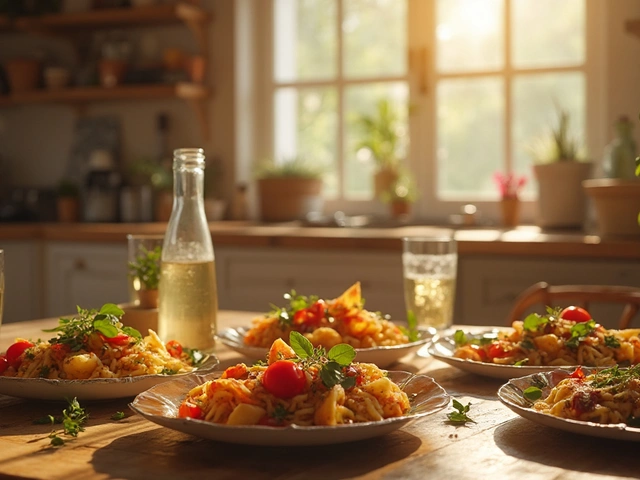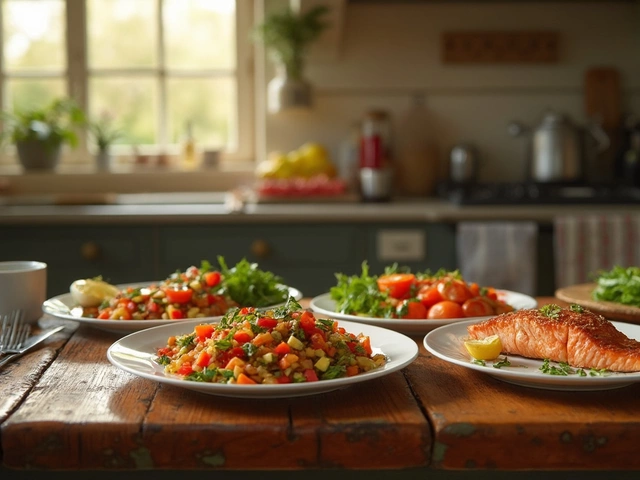When it comes to eating well on a budget, it’s all about choosing the right ingredients. There are certain foods that pack a nutritional punch without the hefty price tag. Think about hearty grains like rice and oats, which not only fill you up but also provide essential nutrients.
Incorporating legumes into your meals can be a game changer. Beans and lentils are affordable protein powerhouses that can easily become the star of your meal or a perfect supplement to other dishes. Eggs, too, offer a wealth of nutrients and a range of cooking possibilities, making them a staple in any economical diet.
Don't overlook the potential of frozen vegetables. They often retain their nutritional value better than their fresh counterparts and can be more cost-effective, especially out of season. Finally, potatoes, with their humble reputation, are incredibly versatile and satisfying.
- The Power of Grains
- Legumes: A Protein-Packed Choice
- The Versatility of Eggs
- Frozen Vegetables: A Hidden Gem
- Maximizing Meals with Potatoes
The Power of Grains
Grains are often the unsung heroes of a balanced diet, offering not only affordability but also a multitude of health benefits. When we talk about grains, we’re looking at a variety such as rice, oats, quinoa, barley, and whole wheat. Each of these absorbs flavors excellently and can be used in an array of dishes, making them versatile ingredients for countless recipes. For centuries, grains have been the cornerstone of dietary habits around the globe, celebrated for their ability to provide energy and nutrition in one affordable package. Consuming grains as part of a regular diet can reduce risks of heart disease, type 2 diabetes, and obesity. They are also excellent sources of fiber, which is crucial for a healthy digestive system. Studies have shown that diets rich in whole grains can contribute to long-term health benefits.
Particularly, brown rice is a whole grain that retains its nutrient-rich outer bran layer, making it a better choice than white rice. It contains carbohydrates that are slowly absorbed into the blood, providing a gradual release of energy. Oats are another excellent grain, often turned into a hearty breakfast, but they're just as potent as ingredients in savory dishes. Because they have high fiber content, oats are terrific for lowering cholesterol levels and providing a prolonged sense of fullness, which can help with weight management. According to the Whole Grains Council, people who eat whole grains as part of a healthy diet have a reduced risk of some chronic diseases. In their words, "Eating grains, especially whole grains, provides health benefits."
Let’s not forget about the nutritional powerhouse that is quinoa, a grain often favored in vegan and vegetarian diets for its complete protein content. It contains all nine essential amino acids, an aspect quite rare for plants, which makes it an excellent choice for maintaining healthy dietary habits. Quinoa is also rich in magnesium, manganese, and phosphorus, all minerals that play key roles in bodily functions. Due to its versatility, quinoa can be used across a spectrum of cuisines, from salads to intricate casseroles, adding nutritional effectiveness to any meal. Including a variety of grains in your diet not only ensures a range of nutrients but also keeps meals interesting and diverse. It's easy to experiment by substituting one grain for another in favorite recipes, introducing different textures and flavors. Truly, grains provide a solid foundation for an affordable and healthy eating plan.
Legumes: A Protein-Packed Choice
Legumes are a true marvel in the world of affordable nutrition. These small but mighty foods encompass a wide range from beans and lentils to peas and chickpeas, all offering exceptional benefits that make them a cornerstone in budget-friendly and healthy eating. The protein content in legumes is astonishingly substantial, often competing with animal proteins, making them an ideal choice for vegetarians, vegans, or anyone looking to reduce their meat consumption without losing out on protein intake. Nutritionally, they are well-revered for their high levels of not just protein, but also fiber, essential nutrients, and antioxidants. Among their virtues, fiber takes the spotlight for promoting digestive health and sustaining a feeling of fullness, which can aid in weight management. This makes legumes a go-to option for anyone seeking to maintain a healthy diet while sticking to a budget. Cheap meals and healthy eating can indeed be aligned with the integration of legumes into daily meals.
Let's dive deeper into the variety you can include in your diet. Black beans, for instance, are a fantastic choice for burritos or soups, adding a creamy texture and rich taste. Lentils, on the other hand, are incredibly versatile; whether part of a hearty stew, a refreshing salad, or a simple curry, they absorb flavors beautifully. Chickpeas, or garbanzo beans, can transform into a delicious homemade hummus or complement a vibrant salad. Then there are kidney beans, which are perfect in chili or slow-cooked dishes, offering a robust and satisfying texture that complements myriad flavors. Each of these brings its unique profile, making meals not just nutritious but exciting.
The affordability of legumes is hard to beat. Dried beans and lentils, in particular, are exceptionally cost-effective, often being the cheapest cheap meals option available in the grocery store aisles. Cooking them does require some time and planning, as most dried legumes need soaking and simmering, but the result is worth the effort. For convenience, canned legumes are a viable alternative, though it's wise to rinse them to reduce sodium content. As a nutritional powerhouse and a staple of affordable cuisine, legumes play a critical role in diets around the world, celebrated for their versatility and economic value.
As stated by Marion Nestle, a reputable nutrition expert, "Legumes are plants with roots that add nitrogen to the soil. They are vital to agricultural sustainability."
Legumes address significant global food challenges by delivering high-quality protein while enhancing soil health, a benefit not just to individual diets but to the broader agricultural ecosystems.Including them in your meal plan can increase your intake of vitamins and minerals, such as iron, folate, and magnesium, at a fraction of the cost compared to other protein-rich foods. Their impact on personal health and environmental sustainability cannot be overstated.
To provide a quantitative perspective, a single cup of cooked lentils contains around 18 grams of protein. When considering dietary decisions, this information is invaluable as it illustrates that substantial protein can be sourced from plant-based foods without breaking the bank. Let's summarize the benefits and practical tips with these key points:
- Versatile: Can be used in soups, stews, salads, and dips.
- Nutritionally dense and rich in protein and fiber.
- Affordable: Dried legumes are typically very low cost.
- Eco-friendly: Contribute to soil health, reducing the need for chemical fertilizers.
- Canned options available, offering convenience and speed in meal preparation.

The Versatility of Eggs
Eggs are truly remarkable when it comes to versatility in the kitchen. They are not just a breakfast staple; they latch onto a variety of meals throughout the day, lending their flavor and nutrients ubiquitously. Whether you're scrambling, boiling, poaching, or whipping them into a soufflé, eggs have earned their spot as a powerhouse ingredient. Nutrient-wise, a single egg contains about 6 grams of protein along with significant amounts of vitamins A, D, and B12. This makes them not only a tasty choice but also a healthy one. They can fit beautifully into budget-eating plans without sacrificing nutrition.
Given their many cooking methods, eggs work well during breakfast, lunch, dinner, or even as a snack. Scramble them with some seasonal vegetables for breakfast or tuck them into burritos. For lunch, why not try a simple egg salad or a classic quiche that enhances their flavors with a humble touch of cream and nutmeg. Deviled eggs or a frittata filled with leftovers from the fridge make for a wonderful dinner option. And desserts aren't left out! From custards to meringues, eggs make sweets rich and satisfying. Speaking candidly, the beauty of eggs shines brightly in their culinary versatility.
The affordability of eggs is another inviting feature as they stretch a meal far beyond their humble appearance. Every now and then, culinary experts suggest that utilizing inexpensive and staple ingredients like eggs can help reduce food waste. Why is this important? You'll often find eggs complementing human mood and health efficiently. According to registered dietitian and nutritionist Elisa Zied, "Eggs are an excellent way to add value to your meal planning by offering substantial nutrition with variety." Their long shelf life further makes them a convenient range in budget cooking.
Eggs can be turned into an exciting adventure for the taste buds. Consider an omelet, filling it with seasonal veggies, herbs, and maybe a sprinkle of cheese for a satisfying low-budget meal. Prepare a shakshuka, a Mediterranean dish of eggs poached in a spicy tomato and pepper sauce, warming and deeply nourishing. Eggs’ versatility allows them to adapt to both simple and complex recipes. From fancy European soufflés to heartwarming East Asian congee topped with a soft-boiled egg—eggs transcend cultural boundaries effortlessly. They’ve sustained many civilizations, echoing culinary traditions worldwide.
For those who question eggs' influence in daily nutrition, a glimpse at some stats demonstrates their importance. According to a health survey, regular egg consumption has been associated with improved muscle strength and cognitive performance, vital attributes for healthy living. Studies consistently highlight that incorporating inexpensive eggs in one's diet can help in managing weight effectively due to their high satiety level. As a key player in affordable nutrition, eggs continue to be celebrated for their rich flavors and nutritious presence in a wide array of global cuisines.
Frozen Vegetables: A Hidden Gem
Hidden in the frosty aisles of your local grocery store are treasures often overlooked—frozen vegetables. These affordable gems rival their fresh counterparts in nutrient density and convenience. Many shoppers might associate frozen goods with a loss of quality, but when it comes to vegetables, the opposite is often true. When vegetables are frozen, they are typically picked at peak ripeness and immediately flash-frozen, locking in their nutritional value. This process helps preserve the vitamins and minerals that might degrade over time in fresh produce exposed to air and light on store shelves.
Another advantage of frozen vegetables is their ability to reduce food waste, a growing concern in today’s world. By maintaining a longer shelf life, these products cater to budget-conscious consumers striving to make the most of their groceries. There's nothing worse than buying fresh broccoli only to have it turn yellow and limp in the fridge. With frozen options, what you purchase today will stay fresh until you're ready to use it, saving you both time and unnecessary trips to the store. Take for example the energy and water savings, as most frozen vegetables come pre-washed and pre-cut. This not only reduces prep time but also limits water usage in your kitchen, making them an eco-friendly choice for environmentally aware consumers.
In culinary versatility, frozen vegetables can hold their own against fresh. Whether it’s tossing them directly into a stir-fry, steaming them for a side dish, or blending them into smoothies, their ease of use is unmatched. Imagine the gourmet meals you can create without the hassle of peeling and chopping. Budget recipes that involve hearty stews or casseroles come to life with the simple addition of mixed frozen veggies, adding both color and nutrition.
"Frozen vegetables are one of the best-kept secrets in the food world," says John Smith, head of nutritional studies at Prestigious University. "They provide a convenient and nutritious option for individuals looking to maintain a healthy diet without breaking the bank."And let's not forget about the economic benefits. Pound for pound, frozen varieties can be significantly cheaper than out-of-season fresh ones, which tend to be flown in from distant locations at a greater cost. That affordability is a great incentive for anyone who cares as much about their wallet as they do about their waistline.
For those tracking nutrient intake, consider the simple breakdown of some popular frozen options. In terms of vitamin retention, frozen spinach can contain just as much iron and calcium after cooking as its fresh equivalent, making it a powerhouse in terms of affordable nutrition. To aid in decision-making, the table below showcases some common frozen vegetables and their nutritional highlights.
| Vegetable | Key Nutrients |
|---|---|
| Spinach | Iron, Calcium, Vitamin C |
| Broccoli | Fiber, Vitamin K, Vitamin C |
| Peas | Protein, Vitamin A, Folate |

Maximizing Meals with Potatoes
Potatoes have often been underestimated, but they are one of the most versatile and budget-friendly foods you can have in your kitchen. Not only do they boast a long shelf life when stored properly, but they also offer a wide array of nutritional benefits. Rich in vitamin C, potassium, and fiber, potatoes can fit into almost any meal plan, providing energy and essential nutrients. When aiming for an affordable nutrition strategy, incorporating potatoes can be both cost-effective and beneficial to your health. One medium-sized potato, for instance, contains only about 100 calories, making it a great base for a meal without overloading on energy. Cheap meals centered around potatoes can be both filling and delicious, allowing for creativity in the kitchen.
When it comes to preparing potatoes, the possibilities are endless. They can be baked, boiled, mashed, or fried, each method unlocking a different flavor profile. Mashed potatoes, for instance, can be a comforting side dish, while roasted potatoes can add a crispy texture to any meal. Potatoes are a blank canvas for spices and herbs, allowing you to infuse them with whatever flavors you happen to fancy. For those trying to eat healthy while budgeting, look no further than the versatile potato. By keeping the skin on, you maximize the nutritional output, retaining much of the fiber and essential vitamins.
Incorporating potatoes in your budget-friendly meals can also mean experimenting with global recipes. Think Spanish tortillas, which combine potatoes with eggs for a protein-rich dish, or Indian aloo gobi, a spiced potato and cauliflower dish that is both hearty and rich in flavor. A significant advantage of using potatoes in cooking is their ability to blend well with almost any ingredient, making them a perfect candidate for soups, stews, and even salads. Potatoes can easily absorb flavors from meat or vegetables simmered alongside them, adding depth to your dishes without requiring extravagant ingredients or techniques.
Historically, potatoes have been a staple food in many cultures. They sustained populations through some of the harshest winters and economic downturns. A study published in the American Journal of Clinical Nutrition even emphasizes the role of potatoes in maintaining gut health, pointing to their high-fiber content which promotes beneficial intestinal bacteria. With such benefits, it’s no wonder that potatoes have been a cornerstone of many diets across the globe. A remarkable fact is that they come in diverse colors ranging from red to purple, each variant offering a unique taste and nutrient profile.
"Potatoes are among the most efficient crops in terms of calories produced per acre of land," according to the International Potato Center. This highlights their sustainability and value in a world pushing towards more eco-friendly food production methods.
For those keen on exploring healthy, budget-friendly meals, here’s a simple guide to a satisfying potato dish:
- Start with washing and dicing your potatoes evenly.
- Toss them with olive oil, salt, pepper, and any herbs you prefer, such as rosemary or thyme.
- Spread them on a baking sheet and roast at 400°F (200°C) for about 30 minutes, turning halfway through for even cooking.
- These roasted potatoes make an excellent side dish for any meal, offering a delightful crunch without excess calories.
Through maximizing your meals with potatoes, you can enjoy the twin benefits of a nutritious diet and remain on budget. Whether it’s whipping up a quick potato salad or indulging in a classic baked potato, the affordability and nutritional density of this humble vegetable are incomparable. So next time you find yourself planning meals, remember the incredible potential packed in this everyday staple.









Write a comment